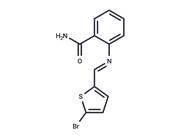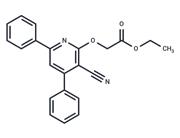| Name | Salermide |
| Description | Salermide, an inhibitor of Sirt1 and Sirt2, induces cancer-specific apoptotic cell death. |
| Cell Research | Cell viability is determined using the 3-(4,5-dimethylthiazol-2-yl)-2,5-diphenyltetrazolium bromide assay as described earlier. IC50 index is calculated using four Salermide concentrations (25, 50, 75 and 100?μm) for 24?h. The percentage of apoptotic cells is determined with the FACSCalibur apparatus.(Only for Reference) |
| In vitro | Salermide prompts tumour-specific cell death in a wide range of human cancer cell lines. The antitumour activity of Salermide is primarily because of a massive induction of apoptosis. Salermide induces apoptosis in cancer but not in normal cells. It induces strong apoptosis without any evident effect on the cell cycle in all the cancer cell lines analysed except in non-tumorigenic MRC5 cells. The induction of apoptosis is cell-type-specific and dose-dependent[1]. |
| In vivo | Salermide is well tolerated by mice at concentrations up to 100 μM, with no adverse health effects observed in terms of diet consumption, body-weight gain, or postural and behavioral changes [1]. |
| Storage | Powder: -20°C for 3 years | In solvent: -80°C for 1 year | Shipping with blue ice. |
| Solubility Information | DMSO : 45 mg/mL (114.08 mM), Sonication is recommended.
|
| Keywords | Inhibitor | Apoptosis | Salermide | inhibit | Sirtuin |
| Inhibitors Related | Stavudine | 5-Fluorouracil | Acetylcysteine | Kaempferol | Myricetin | Sodium 4-phenylbutyrate | L-Ascorbic acid | Dextran sulfate sodium salt (MW 4500-5500) | Metronidazole | Sorafenib | Tributyrin | Lidocaine hydrochloride |
| Related Compound Libraries | Bioactive Compound Library | Epigenetics Compound Library | Chromatin Modification Compound Library | Inhibitor Library | NO PAINS Compound Library | Mitochondria-Targeted Compound Library | Anti-Aging Compound Library | Bioactive Compounds Library Max | Anti-COVID-19 Compound Library | Anti-Cancer Active Compound Library |

 United States
United States



